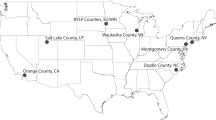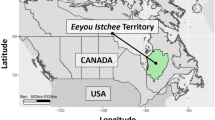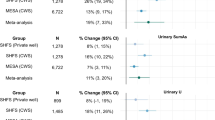Abstract
The National Human Exposure Assessment Survey (NHEXAS) Phase I field study conducted in EPA Region 5 (Great Lakes Area) provides extensive exposure data on a representative sample of approximately 250 residents of the region. Associated environmental media and biomarker (blood, urine) concentration data were also obtained for the study participants to aid in understanding of the relationships of exposures to both contaminant pathways and doses. Besides fulfilling the primary NHEXAS objectives, the NHEXAS data provided an opportunity to explore secondary usages, such as examining pathway to route of exposure relationships. A generic type of structural equation model was used to define the anticipated relationships among the various data types for both arsenic (As) and lead (Pb). Since, by design, only a few participants provided data for all sample types, implementing this model required that some media concentrations (outdoor air and soil) be imputed for subjects with missing information by using measurements collected in the same geographic area and time period. The model, and associated pairwise correlations, generally revealed significant but weak associations among the concentrations, exposures, and doses; the strongest associations occurred for the various air measurements (indoor versus outdoor and personal). The generally weak associations were thought to be partly due to the absence of complete coverage of nonresidential environmental media and to nonsynchronization of relevant measurement times and integration periods of collection across the various sample types. In general, relationships between the NHEXAS questionnaire data and the various concentration, exposure, and body-burden measures were also weak. The model results and the modeling exercise suggest several ways for optimizing the design of future exposure assessment studies that are aimed at supporting structural modeling activities.
This is a preview of subscription content, access via your institution
Access options
Subscribe to this journal
Receive 6 print issues and online access
$259.00 per year
only $43.17 per issue
Buy this article
- Purchase on Springer Link
- Instant access to full article PDF
Prices may be subject to local taxes which are calculated during checkout

Similar content being viewed by others
Abbreviations
- CALIS:
-
Covariance analysis of linear structural equations
- EPA:
-
U.S. Environmental Protection Agency
- GF:
-
goodness of fit
- GLM:
-
general linear model(s)
- HH:
-
household(s)
- LINEQS:
-
linear equations
- MS:
-
mean square
- NHEXAS:
-
National Human Exposure Assessment Survey
- PSU:
-
primary sampling unit
- SEA:
-
structural equation analysis
- TAQ:
-
Time and Activity Questionnaire
- WR:
-
weight ratio
References
Clayton A Pellizzari E Whitmore R Perritt R Quackenboss J, 1999. National Human Exposure Assessment Survey (NHEXAS): distributions and associations of lead, arsenic and volatile organic compounds in EPA Region 5, J Expos Anal Environ Epidemiol. 9(5): 381–392
Pellizzari E Lioy P Quackenboss J Whitmore R Clayton A Freeman N Waldman J Thomas K Rodes C Wilcosky T, 1995. Population-based exposure measurements in EPA Region 5: a Phase I field study in support of the National Human Exposure Assessment Survey, J Expos Anal Environ Epidemiol. 5(3): 327–358
Shumacker RE Lomax RG, 1996 A Beginner's Guide to Structural Equation Modeling. Lawrence Erlbaum Associates, Mahwah, NJ
Thomas KW Pellizzari ED Berry MR, 1999. Population-based dietary intakes and tap water concentrations for selected elements in the EPA Region V National Human Exposure Assessment Survey (NHEXAS), J Expos Anal Environ Epidemiol. 9(5): 402–413
U.S. Environmental Protection Agency 1997 Exposure Factors Handbook: Volume 1. General Factors, EPA/600/P-95/002Fa
Whitmore RW Byron MZ Clayton CA Thomas KW Zelon HS Pellizzari ED Lioy PJ Quackenboss JJ, 1999. Sampling design, response rates, and analysis weights for the National Human Exposure Assessment Survey (NHEXAS) in EPA Region 5, J Expos Anal Environ Epidemiol. 9(5): 369–380
Acknowledgements
We thank K. Thomas, L. Cauble, L. Klemm, M. Herrmann, and J. Roberds for their expert conduct of field activities; L. Michael for his development of the study database; and R. Bender for help with the modeling. We also thank the many participants who provided the data. This research was supported by EPA Cooperative Agreement CR821902-01-0.
Author information
Authors and Affiliations
Rights and permissions
About this article
Cite this article
CLAYTON, C., PELLIZZARI, E. & QUACKENBOSS, J. National Human Exposure Assessment Survey: Analysis of exposure pathways and routes for arsenic and lead in EPA Region 5. J Expo Sci Environ Epidemiol 12, 29–43 (2002). https://doi.org/10.1038/sj.jea.7500198
Received:
Published:
Issue Date:
DOI: https://doi.org/10.1038/sj.jea.7500198
This article is cited by
-
Environmental triggers of COPD symptoms: a cross sectional survey
COPD Research and Practice (2015)
-
Lead in the Japanese living environment
Environmental Health and Preventive Medicine (2012)
-
Determinants of temporal variability in NHEXAS-Maryland environmental concentrations, exposures, and biomarkers
Journal of Exposure Science & Environmental Epidemiology (2005)



